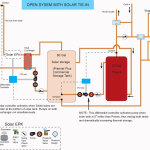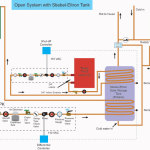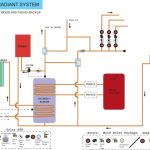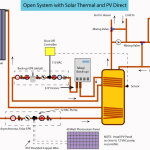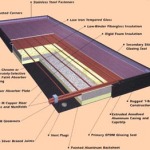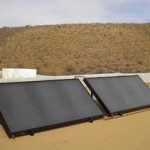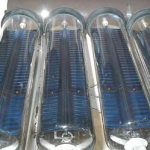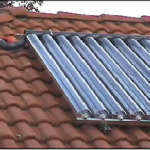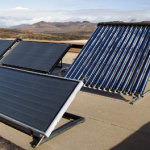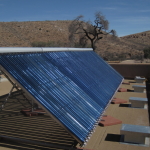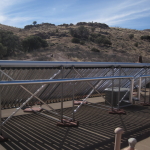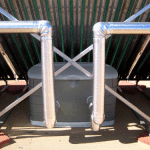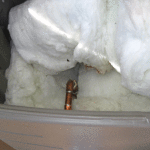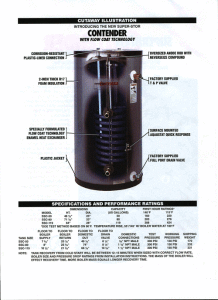Introduction
Contents
Solar water heaters are commonly used as heat sources for radiant floor systems in regions where an abundant solar resource is available. Normally, a large solar heated storage tank (with electric, gas, or oil backup) supplies hot water to the radiant system and most often provides for domestic needs as well.
Solar heaters interface well with radiantly heated floors because the large thermal mass common to radiant systems provides an excellent storage medium for the energy generated during the day. At night, this stored thermal energy is slowly released into the living space and a steady, even, and consistent comfort level is maintained.
The following schematics illustrate the components necessary for a solar based radiant floor heating system. There are several variations on the basic theme.
- Solar Radiant System with External Heat Exchanger
- Solar Radiant System with Internal Heat Exchanger
- Solar Radiant System with the floor in an “open” configuration
- Open System with Solar Thermal and PV Direct
Sensor Placement
Unless you’re using a “PV Direct” solar thermal system (see above schematic), two sensors are required when a solar differential controller (solar relay) is used to trigger the pump sending fluid from the collectors to the solar storage tank. One sensor is placed on the collector at the hottest point of the header, i.e. as the fluid leaves the header and “returns” to the storage tank. The second sensor should be touching the tank itself. It should not be attached to the pipe leading to the tank’s solar heat exchanger.
Some solar storage tanks have a designated sensor port near the bottom of the tank. But, if no port is available, there is often an access panel near the bottom of the tank that will allow the installer to slip the sensor between the tank and the tank’s insulation.
Flat Plate Solar Panels
- Flat Plate Solar Hot Water Panels Cutaway
- Flat Plate Solar Hot Water Collectors
A cutaway and real world application of “flat plate” solar collectors. The environmental benefits are only one of many reasons why solar water heaters are increasingly used in radiant heating systems. Simplicity, efficiency, and proven performance make modern solar equipment an excellent supplemental heat source.
Evacuated Tube Solar Absorbers
- Evacuated tube detail
- Evacuated tube installed
- Combination Flat plate and Evacuated tube installation!
Because the evacuated tubes generate such high temperatures, they should be installed at the end of the solar circuit, effectively turning the flat plates into pre-heaters. Plumbing the tubes before the less efficient flat plates could actually cool the fluid coming from the tubes.
Most people are somewhat familiar with standard flat plate solar collectors. This collector is basically a highly insulated box containing a grid of copper pipes bonded to a flat black copper absorber plate. Special glass enhances solar absorption.
Evacuated tube collectors are an entirely different approach to solar water heating. Instead of many water filled copper pipes, these collectors use multiple vacuum filled glass tubes, each with a tiny amount of antifreeze hermetically sealed within a small central copper pipe. When heated by the sun, this antifreeze converts to steam, rises to the top of the tube, transfers its heat to a collector header, then condenses back into liquid and repeats the process.
Because heat doesn’t easily transfer through a vacuum, 92% of the thermal energy hitting the absorber plate stays within the evacuated tube and passes to the collector header. This is a huge advantage because a standard flat plate collector radiates much of its accumulated heat to the surrounding atmosphere like any other hot object.
The evacuated tubes are also completely modular. Although rarely necessary, one or more tubes can be removed and replaced without affecting the other tubes in the array. There is no actual liquid transferred from the evacuated tube to the collector header…just heat. Evacuated tubes also start absorbing heat earlier in the day than flat plates due to their convex design and the tiny amount of antifreeze within the tube is freeze protected down to -50 degrees below zero.
- To minimize penetrations, this homeowner fastened 2′ X 2′ pavers to the asphalt roof with polyurethane construction adhesive, then used 3″ Tapcon screws to attach the stainless steel flat roof mounting kit to the pavers.
- Notice the highly insulated jacket around the supply and return lines.
- This “deck box” houses the two roof jacks (one for supply, one for return) that actually seal the two roof penetrations from the elements. The box is highly insulated, virtually weather tight, and provides clean and efficient access to the plumbing connections.
- Filling the deck box with fiberglass minimizes the heat loss.
Solar Storage Tanks
Sizing a Solar Radiant Floor System
Due to the many variables inherent with solar, sizing a solar heating system isn’t a simple matter. Latitude, solar orientation, budget, heat loss, type of collector, domestic hot water requirements, esthetics, and performance expectations are all factors needing careful consideration. With unlimited funds, a roof covered with collectors can provide 100% of all hot water needs. More realistically, a modest “starter” system consisting of two or more absorbers can still supply an important boost to the home’s conventional heating system. The basic mechanical components (pumps, heat exchanger, controls, etc.) remain the same regardless of how many collectors may be added later.
A realistic, long term view is important with solar. Granted, the sun begins paying back the investment every time it strikes the collector. But sometimes when you really need the heat, it won’t be there. Even Arizona, New Mexico, and Puerto Rico have cloudy periods. Even a full day of sun on the winter solstice will provide only a weak, short solar opportunity.
But during the spring, summer and fall, an abundance of energy will flood your collectors. Often during these periods, a modest number of collectors will provide 100% of all heating and domestic hot water needs. In the summer, it’s unlikely that any amount of hot water usage could exceed the supply.
So, consider the above factors, discuss your heating needs with one of our technicians, and if solar seems like a viable option, Radiant Floor Company will happily design a system for you.
For those interested in the plumbing details of a solar water heater installation, including photos, see our Solar Installation Details
For details on a ground mount evacuated tube installation, see our information about Evacuated Tube Ground Mount Installation
For details on OVERHEATING PROTECTION for solar water see our section on Solar Overheating Protection

